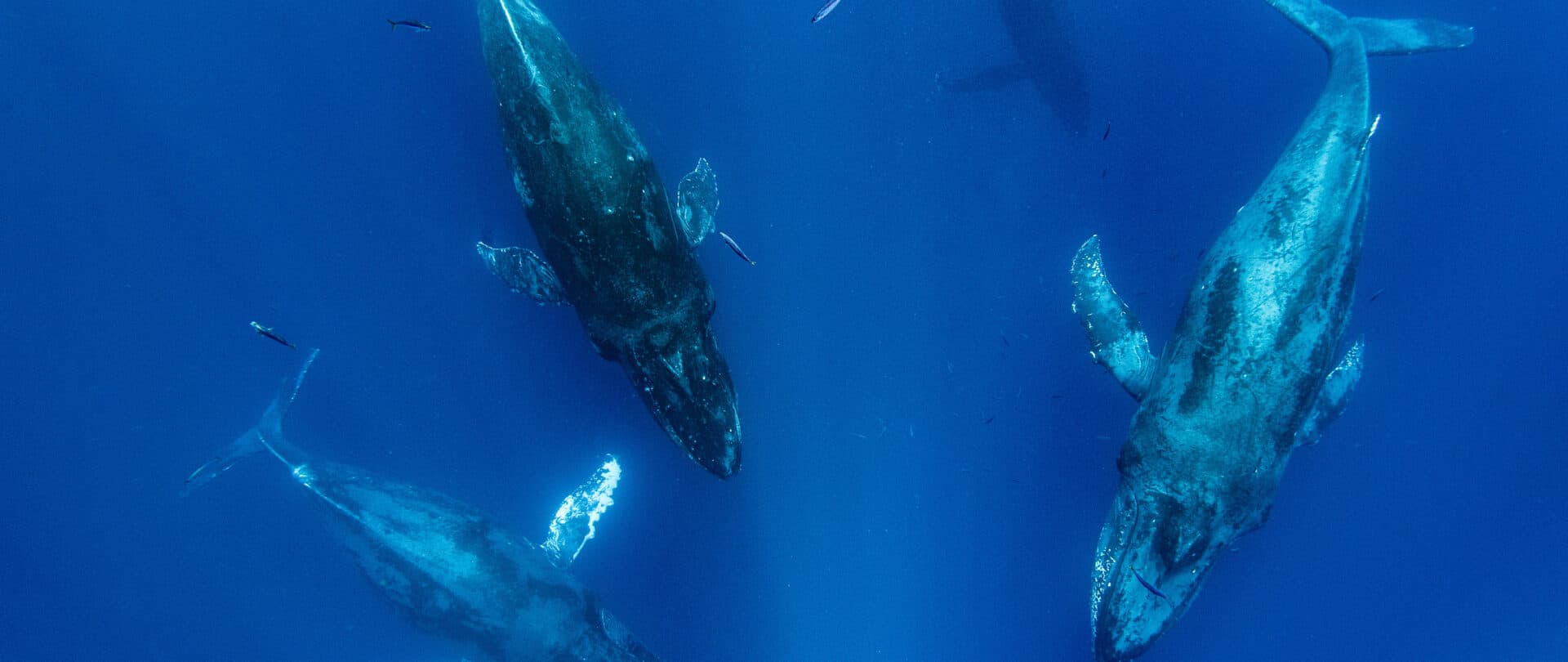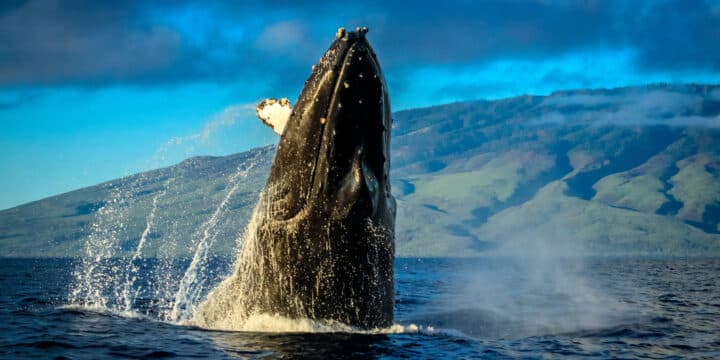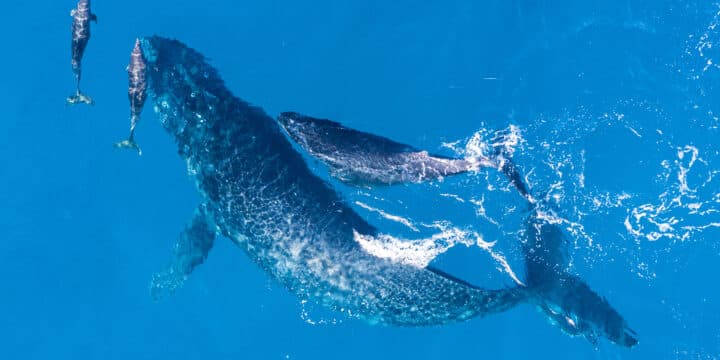
Ralph Pace / Minden Images
Majestic Migrants
Mālama kai—for whales and for our future generations.
BY Andrew Walsh
Where does a whale go to give birth? Not surprisingly, our warm-blooded relatives go to the same place we would, somewhere warm and safe. Somewhere with the best chances of our young one surviving, a place we are familiar with, where each turn and tuck of the landscape comforts us and is ingrained not just in us but in our ancestors. A home that has been passed down through the countless struggles and triumphs of the forbearers who taught us all the skills needed to survive here, the same skills we will pass to our young ones.
Whales come to Hawai‘i because they know these things. They were taught by their mothers, and their mothers before them. Whales are taught to cross the most endless expanse of ocean in the known universe without any modern navigational aids or technology. Even today, the best equipped vessels can disappear without a trace in the blue faceless desert of the Pacific. But whales have learned that somewhere, hidden amongst the vast and seemingly endless waves and wind, lies a place where new life thrives. Not just any place, but a place so special, so unique to the needs of their young, they will forgo food for months on end; swim monotonously for weeks into a blue void; fend off sharks, orcas, and shipping containers; to once again return to the warm temperate climate needed to give birth to a new generation.
Would you do the same if the only place for your young was a hidden oasis 3,000 miles away, accessible only through a maze of hazards and hardships? Of course, you would find a way. Humpbacks have found theirs. But this oasis, this whale paradise deep in the Pacific is just that, nearly a fantasy. More so, a reality existing on the very knife-edge of what these colossal creatures can pull off. Humpbacks risk everything to come here, as there just aren’t many places that offer the same topography and climate conducive to the survival of their young. If there were, they wouldn’t need to risk death, starvation, getting lost or countless other dangers. Why not just stay in their summer feeding grounds in Alaska and give birth there? Because newborns can’t survive the cold waters without adequate blubber, nor fend off the multitude of predators.
So they achieve, to our modern understanding, the unachievable and arrive back here each year to calve and give birth. In fact, scientists really don’t know how they pull off this crossing, though there are many solid ideas and theories. For instance humpbacks may use the magnetic lineations on the seafloor to navigate using specialized magneto-receptors in their head. But really, who knows? And even if that’s true, good luck leaving Anchorage with just a compass and arriving safely in Hawai‘i! What seems better understood is that Hawai‘i is as sacred to them as it is to their distant land-going mammalian cousins. So, imagine after making this journey—after finding that nearly unfindable speck of safety in the dark waters, risking life and fin, exhausted and starving—you arrive. Then, image that this tropical lifeline, for you and the life you carry within, has turned from a glimmer of hope to a watery abyss of bad decisions your mammalian cousins made, robbing you of any future life and any future at all.

This is what climate change does to a whale.
Because just like you and me, whales require a certain range of climate and environmental circumstances to live. Now, you might not worry too much because what do big smelly blowhole breathers really have to do with you? Well, pretty much everything. Whales exist at the very limit of survival. They experience and inhabit the harsh and unforgiving realities of their environment daily. They survive or don’t survive when those conditions become untenable to life. Humans once did the same, but modernity has given us—to a large degree—some separation from our wild reality. However, we are still subject to the same cycles, rhythms, and resources in the natural world. We ignore them at our own peril, yet the plight of whales is a lifeline to our own species. Like all species one step closer to the brink of survival, whales offer us a warning to the environmental crisis that is consuming them, and slowly, us.
We should listen to whales. And not the beautiful, melodious and mysterious language they sing to each other. Rather, it is their silence we should start to notice. New research shows that among the vast array of challenges whales face from pollution, underwater noise, entanglements, habitat destruction, etc., climate change may be the one thing they simply can’t survive. If fossil fuel consumption (the primary driver of climate change) continues at pace, up to 65% of their breeding ground will be at or above an acceptable temperature. In the 20th century, our need for their oil nearly wiped out humpbacks to the point where only a few thousand survived, while so many other whale species went extinct. In the 21st century, it seems oil once again may be their undoing.
Where will whales go on a warming planet? How will they even get there as water temperature is their cue to add blubber, feed and migrate? Everything a whale knows on how to survive is based on cues from the water surrounding their enormous bodies. Like a web of intricately connected parts, it only takes a few strands breaking for it to all fall apart. Humpbacks’ main food supply, tiny ocean-going plankton called krill, are also seriously threatened by warming seas as the ocean ecosystem is profoundly affected by changing temperatures. As the climate warms, countless species like this face an uncertain future in the rapidly changing conditions. Species that we humans indirectly rely on to survive.
Like so many species, krill and humpbacks have everything to do with the long-term success of humans. The ocean regulates all life on Earth by providing the base of the main global food chains, stabilizing and dispersing temperature throughout the planet, producing over half the oxygen to breathe, and is the foundation of the world’s economy through trade, fisheries, tourism and pharmaceuticals. We cannot afford to lose whales. Their plight is our plight. Their troubles are a harbinger for troubles to come for our own species. During whale season, enjoy the site and spectacle of these amazing ocean-dwellers. Hopefully we can reflect and appreciate more than just the beautiful sights and sounds these creatures provide so that we can mālama kai for future generations to come.

Where to see whales on Maui
Whale season in Maui is from November to May, peak season being around mid-January through March. From land, whales can generally start to be seen regularly in December. It is estimated that between 12,000 to 18,000 Humpbacks will migrate to Hawaiian waters. Maui is one of the best spots to see whales as The Maui Nui Basin—a federally protected sanctuary for humpback whales created in the 1990s located in the waters between Maui, Lāna’i and Kaho‘olawe—attracts up to half the population of humpbacks visiting the islands. Most boat tours will leave from Lahaina, Mā‘alaea or Wailea. From land, Lahaina Harbor, Papawai Point, Wailea Beach, Kā‘anapali Beach and Ho‘okipa Beach Park are great viewing locations to see out over the basin and spot whales. Always be careful in and around the ocean when viewing from shore, as the water around the islands can be unforgiving and when taking an ocean tour, make sure to go with a reputable company. Spot some humpbacks, have a blast and we’ll see you out there!
